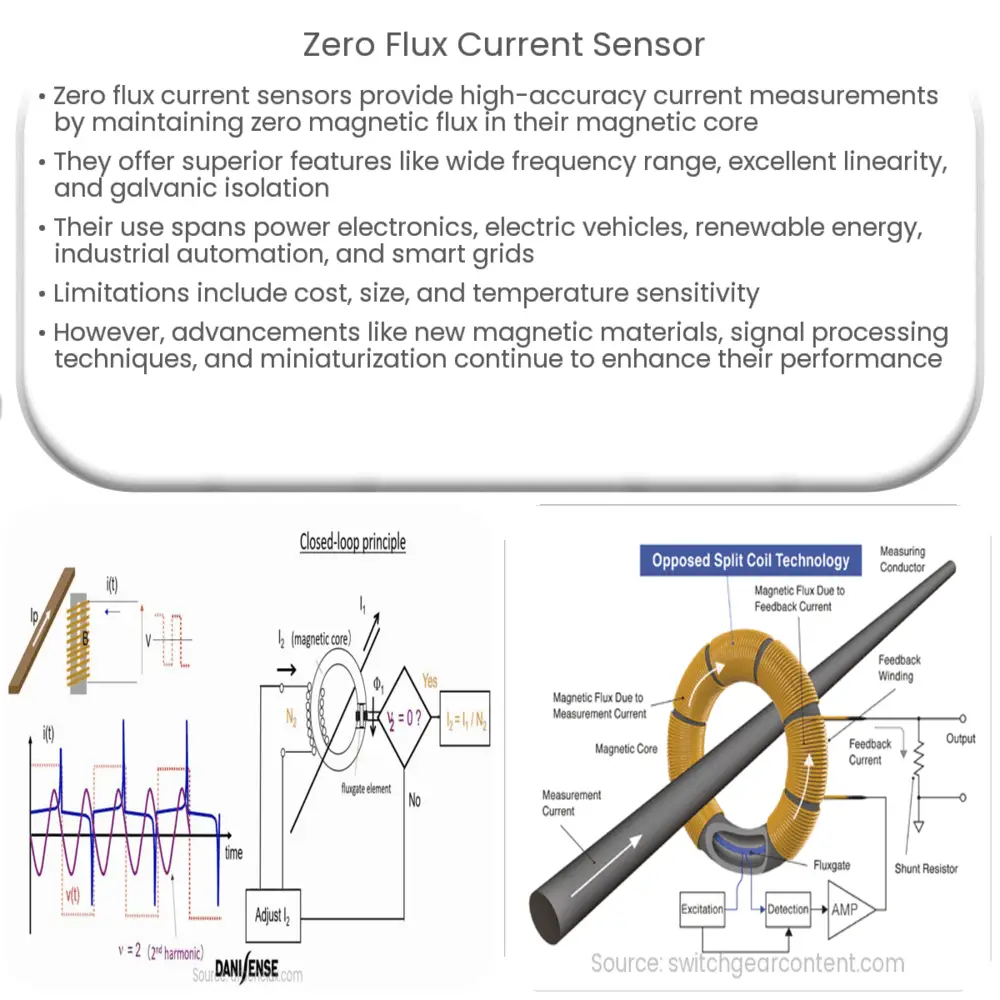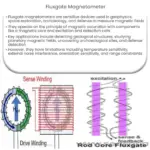Zero flux current sensors provide highly accurate, linear, and stable current measurements in various applications, from power electronics to smart grids.

Zero Flux Current Sensor: An Introduction
What is a Zero Flux Current Sensor?
A zero flux current sensor, also known as a fluxgate current sensor, is a type of magnetic sensor that utilizes the principle of zero magnetic flux to accurately measure alternating or direct electric currents in a conductor. It consists of a magnetic core, a sensing coil, and a compensation coil. The sensor is designed to maintain a magnetic flux of zero in the core, ensuring a precise and stable measurement of the current flowing through the conductor.
Principle of Operation
The fundamental concept behind the zero flux current sensor is the maintenance of a zero magnetic flux state in the magnetic core. This is achieved by winding the sensing coil around the magnetic core and placing the compensation coil near the conductor carrying the current to be measured. The magnetic field generated by the current in the conductor induces a magnetic field in the core. The compensation coil, on the other hand, generates an opposing magnetic field that cancels the magnetic field in the core, thus maintaining a state of zero magnetic flux.
When the magnetic field in the core is at zero, the voltage induced in the sensing coil is also zero. The current in the compensation coil required to maintain this zero flux state is proportional to the current flowing through the conductor, which allows the current to be accurately measured. This principle of operation results in a high level of accuracy, linearity, and sensitivity in the current measurement.
Key Features and Advantages
Zero flux current sensors offer several advantages over other types of current sensors, such as Hall effect sensors and Rogowski coils. Some of the key features and benefits of zero flux current sensors include:
- High Accuracy: Zero flux current sensors provide accurate and stable current measurements with minimal errors. The sensors can achieve a measurement accuracy of up to 0.1% of the full-scale range.
- Wide Frequency Range: These sensors can measure currents across a broad frequency range, from direct currents (DC) to high-frequency alternating currents (AC), making them suitable for various applications.
- Excellent Linearity: Zero flux current sensors exhibit a high degree of linearity in their output, enabling precise measurements over a wide range of current values.
- Galvanic Isolation: The design of zero flux current sensors allows for the separation of the sensing and compensation coils, providing galvanic isolation between the sensor and the conductor. This isolation prevents electrical disturbances from affecting the measurement accuracy and protects the sensor from damage due to high voltage transients.
- Compact Design: Zero flux current sensors are available in compact sizes, making them suitable for integration into various systems and devices.
In the next part of the article, we will discuss common applications, potential limitations, and recent advancements in zero flux current sensor technology.
Common Applications
Zero flux current sensors find applications in various industries and domains due to their high accuracy, wide frequency range, and excellent linearity. Some of the most common applications include:
- Power Electronics: These sensors are used for current measurement in power electronic devices, such as inverters, converters, and power supplies, to ensure proper operation and control.
- Electric Vehicles: Zero flux current sensors are employed in electric vehicles for monitoring and controlling battery charge and discharge currents, as well as motor currents, to optimize energy efficiency and performance.
- Renewable Energy: In solar and wind energy systems, zero flux current sensors are used for accurate current measurement to maximize energy generation and maintain system stability.
- Industrial Automation: These sensors are utilized in various industrial applications, such as robotic systems and motor control, for precise current monitoring and control.
- Smart Grids: Zero flux current sensors play a vital role in smart grid applications, providing accurate current measurements for load monitoring, fault detection, and grid management.
Potential Limitations
Despite their numerous advantages, zero flux current sensors have certain limitations that may impact their suitability for specific applications:
- Cost: Due to their complex design and high-precision components, zero flux current sensors can be more expensive than other types of current sensors, such as Hall effect sensors and Rogowski coils.
- Size and Weight: While compact designs are available, some zero flux current sensors may still be larger and heavier than alternative solutions, which could be a concern for certain space-constrained applications.
- Temperature Sensitivity: The performance of zero flux current sensors can be affected by temperature variations, necessitating the use of temperature compensation techniques to maintain measurement accuracy in extreme temperature environments.
Recent Advancements
Recent research and advancements in zero flux current sensor technology have aimed to address some of the limitations and further improve the performance of these sensors:
- New Materials: Researchers are exploring new magnetic materials with higher permeability and lower core losses, which can enhance the accuracy and sensitivity of zero flux current sensors.
- Advanced Signal Processing: The use of advanced signal processing techniques, such as digital filtering and compensation algorithms, can help reduce the impact of temperature variations and other external factors on the sensor’s performance.
- Miniaturization: Advances in manufacturing technologies have enabled the development of smaller, lighter, and more cost-effective zero flux current sensors, making them suitable for a broader range of applications.
Conclusion
Zero flux current sensors offer numerous advantages, such as high accuracy, excellent linearity, and a wide frequency range, making them suitable for a variety of applications in power electronics, electric vehicles, renewable energy, industrial automation, and smart grids. While certain limitations, such as cost, size, and temperature sensitivity, should be considered, ongoing research and technological advancements are helping to address these issues and further enhance the performance of zero flux current sensors.



